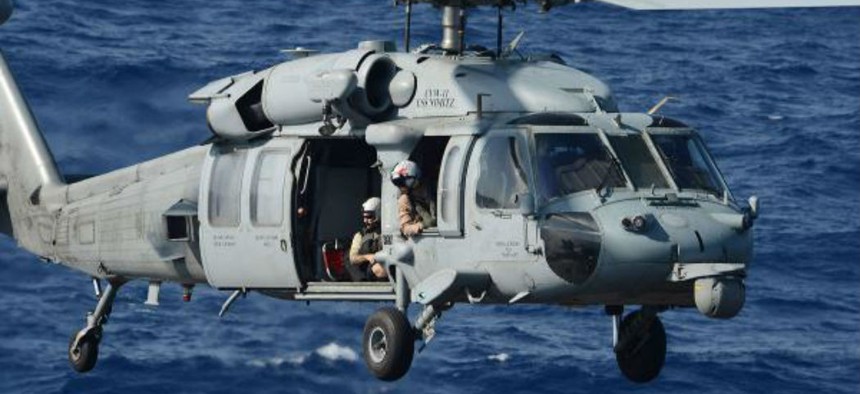Navy laser mine detection now operational
The new airborne mine detection system uses blue-green laser technology and the MH-60S helicopter to perform faster mine-sweeping.
The Airborne Laser Mine Detection System (ALMDS) developed by Northrop Grumman for the MH-60S Seahawk helicopter has reached initial operational capability, according to Navy spokesman Alan Baribeau.
The ALMDS makes use of the motion of the aircraft and advanced bathymetric laser pulse technology to identify and localize mines in shallow areas, such as littoral zones and geographic choke points.
The blue-green laser characteristic of the bathymetric version of Light Detecting and Ranging technology gives the ALMDS maximum depth penetration capabilities, said Baribeau.
According to a Defense Science Journal publication, the wavelength of the blue green laser has the unique ability to maintain about 50 percent of its radiation intensity when penetrating ocean water.
Blue-green lasers emit wavelengths of about 450 to 550nm, according to a report by the Australian Defense Force, with wavelengths closer to 550 nm used for more opaque water, and shorter wavelengths used to penetrate clearer water.
The ALMDS pulsed blue-green laser emits a wavelength of about 510nm, which allows it to operate in a depth of up to 200 meters. As stated in publications from the Geoscience and Remote Sensing Symposium, the system subtracts the time between the reflections of the laser beams that bounce off of the water’s surface and the reflections of laser beams that penetrate the surface in order to calculate depth and orientation.
Also notable, the ALMDS is an entirely self-contained airborne system.
“ALMDS is an optical system flown over the water, not towed through it. This enables the helicopter to conduct mine detection operations at greater speeds. This speed, combined with the laser's wide swath, delivers a high area coverage rate,” explained Baribeau.
This is possible because of its installation on MH-60S helicopters. Originally too small to carry mine detection equipment, the MH-60S can now lend its speed and precision to the Navy’s mine countermeasure (MCM) efforts with the help of the Carriage, Stream, Tow, and Recovery System (CSTRS).
The CSTRS consists of a winch and an external carrier port attached to the MH-60S and is part of the Navy’s initial Organic Airborne Countermeasure program, which was created to help integrate airborne laser mine detection with carrier battle and expeditionary strike groups.
Early this year, the first MH-60S helicopters equipped with the ALMDS passed flight capability testing, and now the system has reached initial operation as part of the MCM force.
“The ALMDS system has been designed to enhance the Airborne MCM capability of the overall US Navy MCM effort…The information collected [will] be combined with all other MCM efforts in the operational area to provide the Combatant Commander with the best situational awareness possible to inform their decisions,” the Navy official told Defense Systems.
Although the ALMDS has not yet reached full-scale deployment, the Navy states that it is available to combatant commanders for tasking.
NEXT STORY: Army acquires ruggedized combat computer tablets





